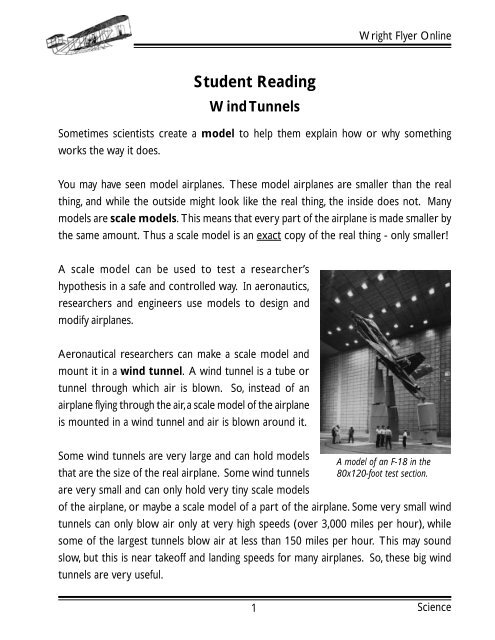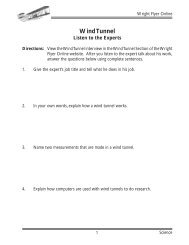Wind Tunnel-Student Reading - NASA Quest!
Wind Tunnel-Student Reading - NASA Quest!
Wind Tunnel-Student Reading - NASA Quest!
You also want an ePaper? Increase the reach of your titles
YUMPU automatically turns print PDFs into web optimized ePapers that Google loves.
Wright Flyer Online<br />
<strong>Student</strong> <strong>Reading</strong><br />
<strong>Wind</strong> <strong>Tunnel</strong>s<br />
Sometimes scientists create a model to help them explain how or why something<br />
works the way it does.<br />
You may have seen model airplanes. These model airplanes are smaller than the real<br />
thing, and while the outside might look like the real thing, the inside does not. Many<br />
models are scale models. This means that every part of the airplane is made smaller by<br />
the same amount. Thus a scale model is an exact copy of the real thing - only smaller!<br />
A scale model can be used to test a researcher’s<br />
hypothesis in a safe and controlled way. In aeronautics,<br />
researchers and engineers use models to design and<br />
modify airplanes.<br />
Aeronautical researchers can make a scale model and<br />
mount it in a wind tunnel. A wind tunnel is a tube or<br />
tunnel through which air is blown. So, instead of an<br />
airplane flying through the air, a scale model of the airplane<br />
is mounted in a wind tunnel and air is blown around it.<br />
Some wind tunnels are very large and can hold models<br />
A model of an F-18 in the<br />
that are the size of the real airplane. Some wind tunnels 80x120-foot test section.<br />
are very small and can only hold very tiny scale models<br />
of the airplane, or maybe a scale model of a part of the airplane. Some very small wind<br />
tunnels can only blow air only at very high speeds (over 3,000 miles per hour), while<br />
some of the largest tunnels blow air at less than 150 miles per hour. This may sound<br />
slow, but this is near takeoff and landing speeds for many airplanes. So, these big wind<br />
tunnels are very useful.<br />
1<br />
Science
Wright Flyer Online<br />
Over the years, <strong>NASA</strong>’s Ames Research Center has operated over 20 wind tunnels of<br />
varying sizes and purposes. Today, however, three major tunnels are used at Ames to<br />
support civilian and military model tests:<br />
1. The National Full-Scale Aerodynamics<br />
Complex (NFAC) contains the 80x120-Foot<br />
<strong>Wind</strong> <strong>Tunnel</strong> and the 40x80-Foot <strong>Wind</strong> <strong>Tunnel</strong>.<br />
In wind tunnels, “80x120-Foot” and<br />
40x80-Foot” indicates dimensions of the<br />
spaces in which the aircraft are tested. Both<br />
do large-scale or full-scale testing of aircraft<br />
and rotorcraft. The 80x120 tunnel will be used<br />
to test the Wright Flyer replica.<br />
2. The Unitary Plan <strong>Wind</strong> <strong>Tunnel</strong> has tested<br />
many models of commercial vehicles and<br />
fighter planes, as well as spacecraft from the<br />
Mercury, Gemini and Apollo programs and the<br />
80x120 <strong>Wind</strong> <strong>Tunnel</strong> at<br />
Space Shuttle. The tunnel contains separate <strong>NASA</strong> Ames Research Center.<br />
test sections for transonic and supersonic<br />
flight testing. In 1985, the facility was named a<br />
National Historic Landmark by the National Park Service because of “its significant<br />
associations with the development of the American Space Program.”<br />
3. The 12-Foot Pressure <strong>Wind</strong> <strong>Tunnel</strong> collects test data to support the development of<br />
high-lift systems for commercial transports and military aircraft and tests high angle-ofattack<br />
of maneuvering aircraft. Increasing the air pressure inside the tunnel makes the<br />
airflow around a small-scale model closer to the flow experienced on a full-size aircraft.<br />
2<br />
Science
Wright Flyer Online<br />
Engineers place instruments on the scale model and in the wind tunnel to take<br />
measurements while the wind is blowing. They measure the forces on the model and the<br />
pressures. All the measurements are collected and analyzed so that the researcher’s<br />
hypothesis may be proved or disproved.<br />
In September 1992, the Los Angeles<br />
Section of the American Institute of<br />
Aeronautics and Astronautics (AIAA)<br />
approached the managers of the wind<br />
tunnels at <strong>NASA</strong> Ames to discuss a<br />
proposal for a test of their full-scale replica<br />
of the 1903 Wright Flyer. Although there<br />
have been some delays due to the<br />
schedules of other customers using the<br />
tunnel, as well as some recent construction<br />
in the tunnel, the Flyer is now on the<br />
80x120-Foot <strong>Wind</strong> <strong>Tunnel</strong> calendar for<br />
1903 Wright Flyer<br />
1999. The test will support two main goals: (1) it will provide aerodynamic data about<br />
the first successful, piloted airplane in history; and (2) the information will be used by<br />
AIAA to build a new, safe, near-replica to be flown at Kitty Hawk, North Carolina on<br />
December 17, 2003 in a centennial celebration of the birth of powered flight.<br />
3<br />
Science










